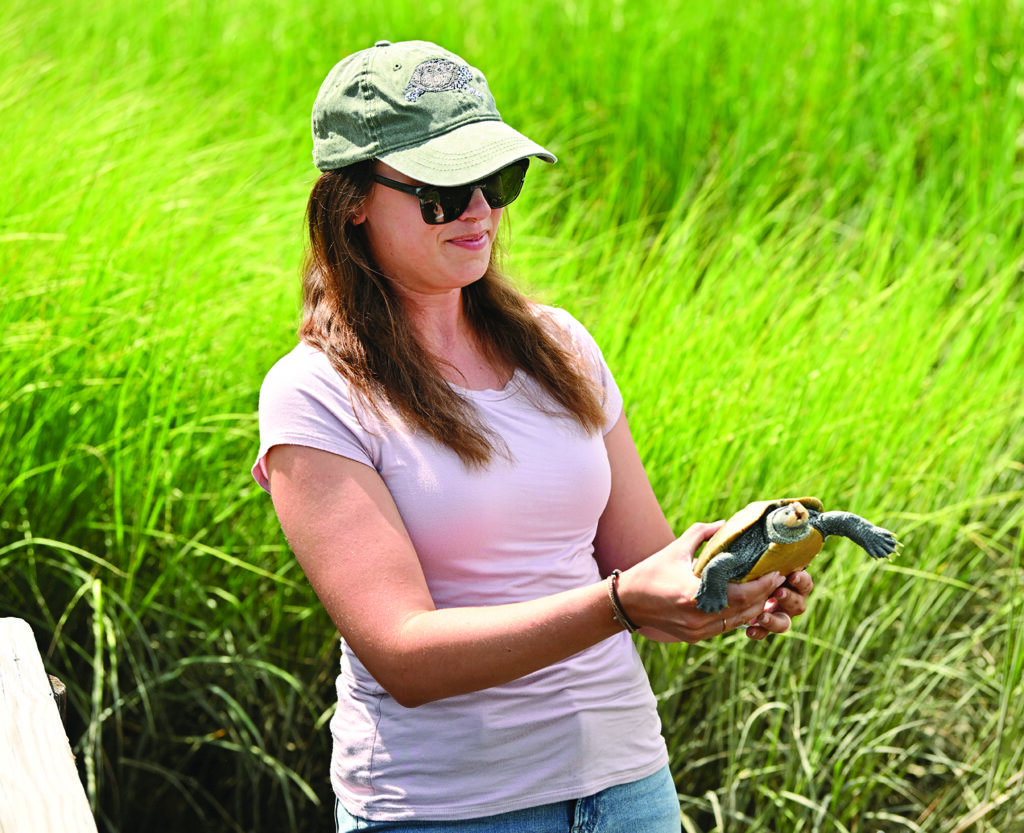Stockton’s Animal Lab helps rehabilitate injured terrapin
OCEAN CITY — It is human intervention when Stockton University’s Animal Lab steps in to help terrapins, but the lab is doing so only because it was human interaction that caused the creatures’ woes in the first place.
“The injured adult females that we get at Stockton University are the repercussions of anthropogenic interactions with humans,” said Melissa Laurino, professional services specialist IV at the Stockton Vivarium. “So we mitigate with some of those living terrapins that unfortunately fall victim. They already have enough stress struggles to survive out here in the wild.”

In more blunt language, she said the terrapins have been hit by vehicles or boat propellers or in other ways harmed by humans.
In the case of Ms. August, a terrapin so named because she was found in August 2024 on the 17th Street beach in Ocean City, it was a fish hook in the mouth that damaged her jaw. She also had damage to her shell from a suspected car or boat strike.
“We help our diamondback terrapins. We help rehabilitate them to get them back into the wild where they belong,” Laurino, an animal care specialist, said in late July.
That is when she, John Rokita, assistant supervisor of Academic Lab Services at Stockton University, and a small group of terrapin rescuers — including the Van Wingerden family who found Ms. August — gathered for her release into Beach Creek at the bay end of West 55th Street in Ocean City.
When Laurino gently placed Ms. August on the rocky and muddy side of the tiny creek, the terrapin quickly made her way to the water and even more quickly swam out of sight some 40 yards away where the creek turned into the tall plants in the marsh.
Rokita said Ms. August was brought to them Aug. 2, 2024. They removed the hook and applied antibiotics to keep the area from getting infected.
“And then it was a long battle of hand-feeding her because of her mouth injury,” he said, whether because of lack of hunger or pain from the injury.
“We were hand-feeding her every day until finally, maybe four or five months ago, she started eating on her own, thank God. And then she started eating like crazy and putting on all this weight,” Rokita said.
Ms. August was getting chopped fish and a pelleted turtle food, which was hard but that she was able to crunch with her mandibles in spite of her injury, he explained. That is important because terrapins’ favorite food is moampus snails, small snails in shells found in salt mashes.
“We figured if she could crunch this hard, pelleted food, she could also crunch snails,” he said.
Ms. August is a northern diamondback terrapin. Rokita said they weren’t sure of her exact age, but she is probably in the 15- to 20-year range. “They can live a very long time,” he said.
The terrapin rescue project was started in 1989 by Dr. Roger Wood, a retired zoologist from Stockton University.
“He saw the massacre every year on the shore community roadways where terrapins would get hit by the hundreds during nesting season,” Rokita said. “He came up with this idea that maybe the eggs could still be salvaged out of females versus going back to where they deposited their eggs.” (This is in case they were hit on the way to laying their eggs.)
Rokita explained it is a conservation effort to replace the injured females hit on the roadways. At Stockton they incubate the eggs at a higher temperature, 30 degrees celsius, rather than at 26 degrees celsius, because the eggs develop faster. He further explained that terrapin sex isn’t determined by genetics (“not chromosomal dependent like dogs, cats or people”) but by temperature.
The higher temperature helps them develop faster and produces only females because they’re the ones being hit.
Rescuing terrapins
The Diamondback Terrapin Rescue Project rehabilitates 500 to 1,000 terrapins each year.
Rokita and Laurino said they’re at it 365 days a year, including weekends and holidays.
“We don’t sleep there, but we’re there quite a bit,” Rokita said.
“It’s a lot of work, don’t get me wrong,” he aded.
That work includes changing pools to make their own brackish water to replicate the marsh environment.
“There’s a lot of dirty work that goes along with getting these guys healthy and back into the wild again, but we wouldn’t be there if we didn’t enjoy it.”
Not only does the project help save terrapins, but they use it as an educational tool for visits from students in kindergarten, who get to release terrapins, through college.
“It kind of brings home the message to slow down for terrapins,” Rokita said, “making youngsters very much aware of the terrapin issue from a very early age. As Melissa said, the majority of the terrapins we get are all brought to us somehow with a human-related problem.
“If they fall into a storm drain, that’s not natural. They get hit by a car, they get hit by a boat propeller, a fish hook — there’s always some sort of human connection.”
The two of them work at the vivarium at Stockton and provide hands-on experience for undergraduates and graduate students, some of whom may go on to veterinary school.
Rhonda Van Wingerden, whose family found the turtle and brought it to Stockton, thought it was interesting that a turtle that lives in the bay was found on a beach by the ocean. Before it was released, she took it to the Wetlands Institute to be microchipped. (See related story.) Then her family handed it off to the Stockton duo.
“Their dedication is just amazing,” she said of the staff at the lab. “To think that something that if left there she would never have survived without the human intervention that they gave at Stockton. Just the patience to continue, even though at times the turtle was spitting food back out at them. They continue despite the challenges that they come across and despite the severity of her injury.”
If you find an injured terrapin
If someone finds an injured terrapin, they should call Rokita or Laurino at the Stockton vivarium at (609) 452-4581. (Ask for John or Melissa.) They are at the vivarium seven days a week.
The first thing, according to Rokita, is get the terrapin out of harm’s way, whether it’s on a street or other location.
Until a person is able to transport it to Stockton, he recommends placing it in a well-ventilated cardboard box in a cool, shady spot, perhaps a garage.
By DAVID NAHAN/Cape May Star and Wave


